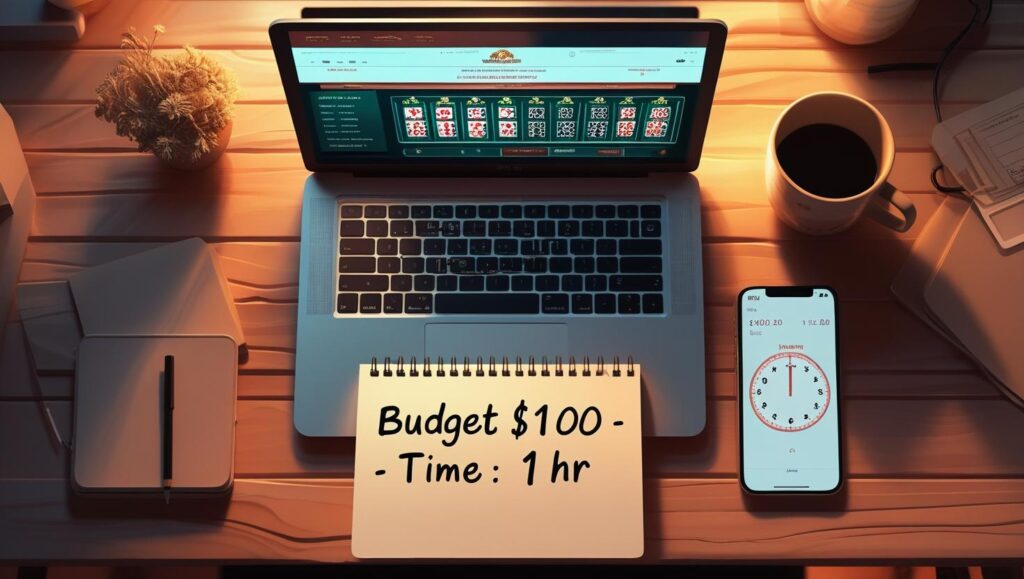Whether you’re spinning slots for fun or placing calculated bets on your favorite game, setting a clear gambling budget is one of the smartest things you can do. It doesn’t matter if you’re a casual player or chasing professional-level edges — bankroll management is your foundation. This guide walks you through how to set a gambling budget that protects your wallet and maximizes your enjoyment.
Quick Navigation
Why Setting a Gambling Budget Matters
Gambling is entertainment — but unlike dinner and a movie, the final cost can vary wildly. Without a plan, it’s easy to overspend, chase losses, or walk away with regret instead of a good time. A proper budget keeps gambling fun, manageable, and safe.
Even pros rely on strict bankroll planning. They’re not just betting for fun — it’s their income. If they go broke, they can’t keep playing. For casual players, the goal is to avoid going beyond what you can comfortably afford.
➡️ If you want a deeper understanding of how gambling affects decision-making, take a look at this FAQ from the National Council on Problem Gambling. It offers guidance on safe gambling practices and helps reinforce why sticking to a budget matters, especially for recreational players.
Step-by-Step: How to Set Your Gambling Budget

🔹 Step 1: Know Your Real Entertainment Budget
Start with your monthly take-home income. Subtract essential living costs like rent, food, healthcare, and savings. Whatever’s left is your entertainment allowance — the pool for movies, hobbies, and yes, gambling.
Example:
- Income: $3,500/month
- Essentials: $2,500
- Left for fun: $1,000
- Allocate 25% to gambling: $250
🔹 Step 2: Decide Your Gambling Style
Are you someone who wants longer, relaxing sessions or quick thrill bursts? This affects how you stretch your budget. Playing with smaller stakes for longer keeps the entertainment going, while high stakes burn your bankroll faster.
🔹 Step 3: Set Time & Money Limits
Stick to double or triple limits:
- ⏱️ Time limit: e.g., 1 hour per session
- 💸 Loss limit: e.g., $100 max loss
- 🎯 Optional win cap: e.g., stop if you’re up $100
These limits keep you from chasing losses and help you walk away while you’re ahead.
Budgeting Methods: Which One Fits You?
📊 Method 1: The Double/Triple Limit
Set both a time cap and loss limit, with an optional win goal. Example: “I’ll play for 1 hour, stop if I lose $50 or win $75.”
Pros: Keeps you safe on both time and money.
Cons: You may have to end a fun session early.
📉 Method 2: Budget for Expected Losses
If you know the game’s RTP (return to player), you can estimate your average loss per session.
Example:
600 spins at $1/spin on a 96% RTP slot = avg. $24 loss
Pros: Lets you gamble for time, not just budget.
Cons: Requires strong discipline to weather unlucky streaks.
💰 Method 3: The Gambling Fund
Set aside a fixed amount weekly/monthly (e.g., $25/week). If you win, let it grow. If you lose, don’t reload early.
Pros: Flexible and allows rollovers.
Cons: No time limits unless you create your own rules.
Watch Out for Double-Spending Winnings
If you win $200 and spend it on shopping, then still treat it as part of your gambling bankroll — that’s double spending. It makes future losses feel worse because that money’s already gone.
Rule of thumb: Cash out winnings you plan to spend. Don’t leave them in your gambling account unless you’re okay with losing them.
How Professionals Handle It
Pros use mathematical tools like the Kelly Criterion to determine how much to stake based on their edge. For recreational players, though, the takeaway is simple: professionals risk very small percentages of their bankroll — usually 1% to 3% per bet.
In games with no player edge (like slots or roulette), the math says don’t bet at all if you want to profit — proving again that for most people, gambling should be budgeted as entertainment, not income.
📚 If you’re interested in the math behind it, here’s a great primer on Kelly Criterion strategy via Investopedia. This resource breaks down the formula and helps you understand how professionals decide how much to bet when the odds are in their favor.
Tips to Stick to Your Budget

- ✅ Use casino tools to set deposit/time/loss limits — Most regulated online casinos let you set daily, weekly, or monthly spending caps. Use these features to build in discipline from the start.
- ✅ Track your wins and losses — don’t rely on memory. Use a spreadsheet or budgeting app to log your sessions. You might be surprised how often the numbers differ from what you “feel” you’ve won or lost.
- ✅ Don’t chase losses — it leads to overspending. Losing streaks happen. The worst thing you can do is try to recover your losses by betting more. Instead, step away and reassess.
- ✅ Separate your gambling money from your savings/checking account. Use a separate e-wallet or prepaid card to create a firewall between your entertainment spending and your essentials.
- ✅ Take breaks often — especially after big wins or losses. Emotional swings lead to impulsive decisions. Walking away after a high or low helps you stay rational.
- ✅ Plan sessions ahead of time. Decide when, how long, and how much you’ll play — and stick to it. Gambling should never be spontaneous when it comes to money.
- ✅ Set win goals, not just loss limits. Knowing when to walk away with a profit helps prevent losing it all in a late-session spiral.
- ✅ Reward yourself for sticking to your limits. Just like going to the gym or eating healthy, keeping discipline with gambling deserves some positive reinforcement — even if it’s just acknowledgment.
Final Thought
Setting a gambling budget doesn’t limit your fun — it protects it. It gives you the peace of mind to enjoy the games, whether you win or lose. It turns gambling from something risky into something controlled and intentional.
If you’re playing to have fun, budgeting helps you keep it that way.
Need help building a safer strategy or curious about how others manage their bankrolls? Explore more guides at StakesCheck — where smart play starts.

